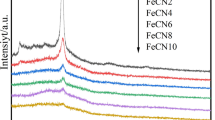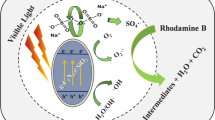Abstract
Environmental protection treatment process relies on the robustness, durability, and performance of catalysts to drive the development of cutting-edge sustainable technologies for the elimination of refractory contaminants. Herein, prepared SrCoO2.5 were successfully prepared through citric acid by sol-gel method, and further utilized as super catalysts to degrade Rhodamine B (RhB) by coupling with peroxymonosulfate (PMS) in environmental protection. Three optimized parameters (SrCoO2.5 dosage of 0.2 g L−1, PMS concentration of 0.93 g L−1, and initial pH of 2) were obtained via Conditional test method in environmental protection. Benefiting from the larger specific surface area, pore-volume, and existence of abundant hydroxyl groups, SrCoO2.5 prepared through citric acid by sol-gel method with more available active sites exhibited an super efficiency of 99.4% toward catalytic degradation of RhB within 10 min under the optimal conditions. Moreover, SrCoO2.5 demonstrated durability and long-term stability even during the seven consecutive cycle, it almost regenerates in 500 °C for 1 h. The scavenging experiments and electron paramagnetic resonance technologies revealed that non-radical singlet oxygen (1O2), sulfate radicals(SO4•−) were associated as active species in the SrCoO2.5/PMS system. Besides, the reaction mechanism on the SrCoO2.5 degradation pathways toward RhB was speculated under PMS activation. The results indicated that the synergistic effects between Co–Sr structures not only significantly boosted the removal efficiency and long-term stability of SrCoO2.5. But also facilitated the redox cycles of Co3+/Co2+ and Sr3+/Sr2+, which produce 1O2. This proof-of-concept approach to develop such high-efficient Co–Sr structures produced Co3+/Co2+ and Sr3+/Sr2+ will open up novel avenues for wastewater decontamination via PMS activation.

Highlights
-
SrCoO2.5 materials for environmental protection industry are rarely reported. Such a meaningful applying strategy that involves the SrCoO2.5 materials for environmental protection industry, as far as we know, has not been reported to activate PMS for remediating RhB in wastewater. Furthermore, the detailed mechanistic study also requires an in-depth discussion.
-
SrCoO2.5 materials produce 1O2 was reported.
-
Synthesis of SrCoO2.5 with citric acid as the precursor was reported.
-
Regeneration of SrCoO2.5 materials was reported.













Similar content being viewed by others
Data availability
[DATA TYPE] The data used to support the findings of this study are available from the corresponding author upon request.
References
Favier L, Harja M, Simion AI et al. (2016) Advanced Oxidation Process for the Removal of Chlorinated Phenols in Aqueous Suspensions. J Environ Prot Ecol 17(3):1132–41
Song Y, Li N, Chen D et al. (2018) 3D ordered MoP inverse opals deposited with CdS quantum dots for enhanced visible light photocatalytic activity. Appl Catal B: Environ 238:255–62
Zhang R, Wan Y, Peng J et al. (2019) Efficient degradation of atrazine by LaCoO3/Al2O3 catalyzed peroxymonosulfate: Performance, degradation intermediates and mechanism. Chem Eng J 372:796–808
Qi C, Liu X, Ma J et al. (2016) Activation of peroxymonosulfate by base: implications for the degradation of organic pollutants. Chemosphere 151:280–8
Jia Z, Wang JC, Liang SX et al. (2017) Activation of peroxymonosulfate by Fe78Si9B13 metallic glass: the influence of crystallization. J Alloys Compd 728:525–33
Garcia C R, Oliva J, Chávez D, et al. (2020) Effect of Bismuth Dopant on the Photocatalytic Properties of SrTiO3 Under Solar Irradiation. Top Catal 1–12. https://doi.org/10.1007/s11244-020-01391-z
Oliva J, Sanches J, Santoyo J, et al. (2020) Enhancing the Photocatalytic Degradation of Ciprofloxacin Contaminant Using a Combined Laser Irradiation (285/365 nm) and Porous g-C3N4. Mater Chem Phys 252. https://doi.org/10.1016/j.matchemphys.2020.123198
Márquez-Herrera A, Ovando-Medina VM, Castillo-Reyes BE et al. (2014) A novel synthesis of SrCO3–SrTiO3 nanocomposites with high photocatalytic activity. J Nanopart Res 16(12):1–10
Chen Z B(2009) A novel visible-light-sensitive strontium carbonate photocatalyst with high photocatalytic activity. Catal Commun 10:1565–1568
Tang L, Liu Y, Wang J et al. (2018) Enhanced activation process of persulfate by mesoporous carbon for degradation of aqueous organic pollutants: electron transfer mechanism. Appl Catal B: Environ 231:1–10
Wang G, Cheng C, Zhu J et al. (2019) Enhanced degradation of atrazine by nanoscale LaFe1-xCuxO3-δ perovskite activated peroxymonosulfate: performance and mechanism Sci Total Environ 673:565–75
Chen X, Oh W-D, Hu Z-T et al. (2018) Enhancing sulfacetamide degradation by peroxymonosulfate activation with N-doped graphene produced through delicately-controlled nitrogen functionalization via tweaking thermal annealing processes. Appl Catal B: Environ 225:243–57
Zhao W, Liu Y, Wei Z et al. (2016) Fabrication of a novel p–n heterojunction photocatalyst n-BiVO4@p-MoS2 with core–shell structure and its excellent visible-light photocatalytic reduction and oxidation activities. Appl Catal B: Environ 185:242–52
Liu C, Chen L, Ding D et al. (2019) From rice straw to magnetically recoverable nitrogen doped biochar: efficient activation of peroxymonosulfate for the degradation of metolachlor. Appl Catal B: Environ 254:312–20
Li X, Hu Z, Liu J et al. (2016) Ga doped ZnO photonic crystals with enhanced photocatalytic activity and its reaction mechanism. Appl Catal B: Environ 195:29–38
Oh W-D, Dong Z, Lim T-T (2016) Generation of sulfate radical through heterogeneous catalysis for organic contaminants removal: Current development, challenges and prospects. Appl Catal B: Environ 194:169–201
Huang X, Hou X, Zhao J et al. (2016) Hematite facet confined ferrous ions as high efficient Fenton catalysts to degrade organic contaminants by lowering H2O2 decomposition energetic span. Appl Catal B: Environ 181:127–37
Park CM, Heo J, Wang D et al. (2018) Heterogeneous activation of persulfate by reduced graphene oxide-elemental silver/magnetite nanohybrids for the oxidative degradation of pharmaceuticals and endocrine disrupting compounds in water. Appl Catal B 225:91–9
Yue D, Zhang T, Kan M et al. (2016) Highly photocatalytic active thiomolybdate [Mo3S13]2− clusters/BiOBr nanocomposite with enhanced sulfur tolerance. Appl Catal B: Environ 183:1–7
Qian X, Ren M, Fang M et al. (2018) Hydrophilic mesoporous carbon as iron(III)/(II) electron shuttle for visible light enhanced Fenton-like degradation of organic pollutants. Appl Catal B: Environ 231:108–14
Duan X, Ao Z, Sun H et al. (2015) Insights into N-doping in single-walled carbon nanotubes for enhanced activation of superoxides: a mechanistic study. Chem Commun (Camb) 51(83):15249–52
Zhou Q, Xu S, Yang C et al. (2016) Modulation of peripheral substituents of cobalt thioporphyrazines and their photocatalytic activity. Appl Catal B: Environ 192:108–15
Duan X, Sun H, Shao Z et al. (2018) Nonradical reactions in environmental remediation processes: uncertainty and challenges. Appl Catal B: Environ 224:973–82
Arfaoui J, Ghorbel A, Petitto C et al. (2018) Novel V2O5-CeO2-TiO2-SO42− − nanostructured aerogel catalyst for the low temperature selective catalytic reduction of NO by NH3 in excess O2. Appl Catal B: Environ 224:264–75
Xia D, He H, Liu H et al. (2018) Persulfate-mediated catalytic and photocatalytic bacterial inactivation by magnetic natural ilmenite. Appl Catal B: Environ 238:70–81
Zhou Y, Zhang Y, Hu X(2020) Novel zero-valent Co-Fe encapsulated in nitrogen-doped porous carbon nanocomposites derived from CoFe2O4@ZIF-67 for boosting 4-chlorophenol removal via coupling peroxymonosulfate J Colloid Interfac Sci 575:206–19
Zhou Y, Zhang Y, Hu X (2020) Enhanced activation of peroxymonosulfate using oxygen vacancy-enriched FeCo2O4−x spinel for 2,4-dichlorophenol removal: Singlet oxygen-dominated nonradical process. Coll Surf A: Physicochem Eng Asp 597:124568
Pang X, Guo Y, Zhang Y et al. (2016) LaCoO3 perovskite oxide activation of peroxymonosulfate for aqueous 2-phenyl-5-sulfobenzimidazole degradation: Effect of synthetic method and the reaction mechanism. Chem Eng J 304:897–907
Peña MA, Fierro JL (2001) Chemical structures and performance of perovskite oxides. Chem Rev 101(7):1981–2017
Demirel S, Oz E, Altin S et al. (2017) Structural, magnetic, electrical and electrochemical properties of SrCoO2.5, Sr9Co2Mn5O21 and SrMnO3 compounds Ceram Int 43(17):14818–26
Hammouda SB, Zhao F, Safaei Z et al. (2017) Degradation and mineralization of phenol in aqueous medium by heterogeneous monopersulfate activation on nanostructured cobalt based-perovskite catalysts ACoO3(A = La,Ba,Sr and Ce): characterization, kinetics and mechanism study. Appl Catal B: Environ 215:60–73
Jie, Dai, Xiaoguang, et al. (2019) Boosting performance of lanthanide magnetism perovskite for advanced oxidation through lattice doping with catalytically inert element. Chem Eng J https://doi.org/10.1016/j.cej.2018.08.192
Hao L, Yan J, Guan S et al. (2019) Oxygen vacancies in TiO2/SnO coatings prepared by ball milling followed by calcination and their influence on the photocatalytic activity Appl Surf Sci 466:490–7
Huang Z, Wang T, Shen M et al. (2019) Coagulation treatment of swine wastewater by the method of in-situ forming layered double hydroxides and sludge recycling for preparation of biochar composite catalyst. Chem Eng J 369:784–92
Yi-Zhu P, Wan-Hong M, Man-Ke J et al. (2016) Comparing the degradation of acetochlor to RhB using BiOBr under visible light: a significantly different rate-catalyst dose relationship. Appl Catal B: Environ 181:517–23
Zeng L, Xiao L, Shi X et al. (2019) Core-shell Prussian blue analogues@ poly(m-phenylenediamine) as efficient peroxymonosulfate activators for degradation of Rhodamine B with reduced metal leaching. J Coll Interfac Sci 534:586–94
Wang J, Xia Y, Dong Y et al. (2016) Defect-rich ZnO nanosheets of high surface area as an efficient visible-light photocatalyst. Appl Catal B: Environ 192:8–16
Jaiswal R, Patel N, Dashora A et al. (2016) Efficient Co-B-codoped TiO2 photocatalyst for degradation of organic water pollutant under visible light Appl Catal B: Environ 183:242–53
Chen Z, Jiang H, Jin W et al. (2016) Enhanced photocatalytic performance over Bi4Ti3O12 nanosheets with controllable size and exposed {0 0 1} facets for Rhodamine B degradation. Appl Catal B: Environ 180:698–706
Shao L, Jiang D, Xiao P et al. (2016) Enhancement of g-C3N4 nanosheets photocatalysis by synergistic interaction of ZnS microsphere and RGO inducing multistep charge transfer Appl Catal B: Environ 198:200–10
Zhang X, Zhang J, Yu J et al. (2018) Fabrication of InVO4/AgVO3 heterojunctions with enhanced photocatalytic antifouling efficiency under visible-light. Appl Catal B: Environ 220:57–66
Elbanna O, Zhang P, Fujitsuka M et al. (2016) Facile preparation of nitrogen and fluorine codoped TiO2 mesocrystal with visible light photocatalytic activity. Appl Catal B: Environ 192:80–7
Huang Y, Kang S, Yang Y et al. (2016) Facile synthesis of Bi/Bi2WO6 nanocomposite with enhanced photocatalytic activity under visible light. Appl Catal B: Environ 196:89–99
Acknowledgements
This work was supported by the 2016 Foshan Science and Technology Project (2016GA10159), the Natural Science Foundation of Guangdong Province (2014A030312007) and the China Postdoctoral Science Foundation (2014M552202).
Author information
Authors and Affiliations
Corresponding author
Ethics declarations
Conflict of interest
The authors declare no competing interests.
Additional information
Publisher’s note Springer Nature remains neutral with regard to jurisdictional claims in published maps and institutional affiliations.
Rights and permissions
About this article
Cite this article
He, L., Zhang, Y. Singlet oxygen produced SrCoO2.5 in environmental protection: extraordinary electronic properties and promoted catalytic performance. J Sol-Gel Sci Technol 99, 391–401 (2021). https://doi.org/10.1007/s10971-021-05574-2
Received:
Accepted:
Published:
Issue Date:
DOI: https://doi.org/10.1007/s10971-021-05574-2




